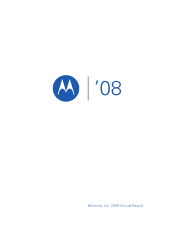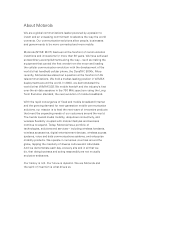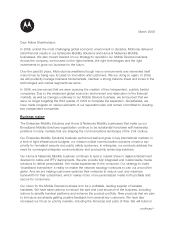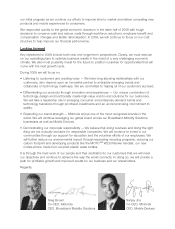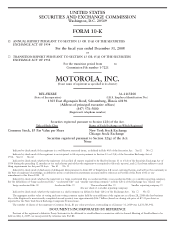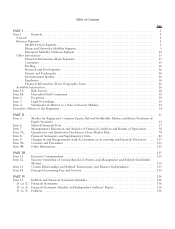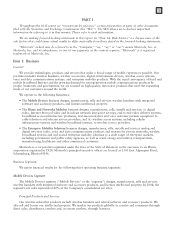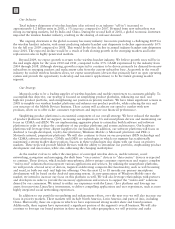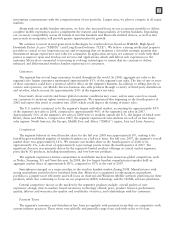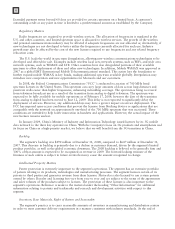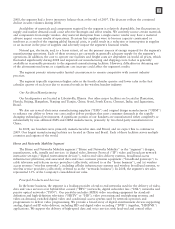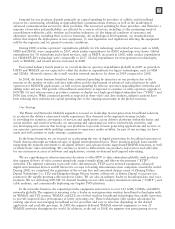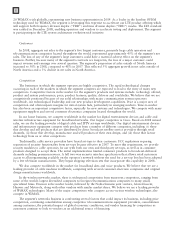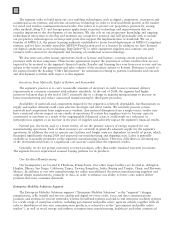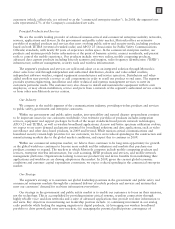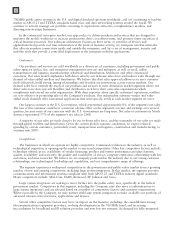Motorola 2008 Annual Report Download - page 10
Download and view the complete annual report
Please find page 10 of the 2008 Motorola annual report below. You can navigate through the pages in the report by either clicking on the pages listed below, or by using the keyword search tool below to find specific information within the annual report.
Our Industry
Total industry shipments of wireless handsets (also referred to as industry “sell-in”) increased to
approximately 1.2 billion units in 2008, a 5% increase compared to 2007. Demand from new subscribers was
strong in emerging markets, led by India and China. During the second half of 2008, a global economic downturn
impacted the wireless handset industry, resulting in the slowing of end-user demand.
The ongoing downturn in the global economy has many industry forecasters predicting a challenging 2009 for
the wireless handset industry, with many predicting industry handset unit shipments to decline approximately 10%
for the full year 2009 compared to 2008. This would be the first decline in annual industry handset unit shipments
since 2001. The expected decline would be a result of both slowing growth in the emerging markets and lower
replacement sales in highly-penetrated markets.
Beyond 2009, we expect growth to return to the wireless handset industry. We believe growth rates will be in
the mid single digits for the years 2010 and 2011, compared to the 15% CAGR experienced by the industry from
2004 through 2008. Although slowing, growth is expected to continue to be driven primarily by demand from new
subscribers in emerging markets and replacement sales from the current subscriber base. As growth in the overall
industry for mobile wireless handsets slows, we expect smartphones (devices that primarily have an open operating
system and provide the opportunity to develop and run native applications) to be the fastest growing market
segment.
Our Strategy
Motorola seeks to be a leading supplier of wireless handsets and mobile experiences to customers globally. To
accomplish this objective, our strategy is focused on simplifying product platforms, enhancing our mid- and
high-tier product portfolio, and strengthening our position in priority markets. We have taken significant actions in
2008 to simplify our wireless handset platforms and enhance our product portfolio, while reducing the size and
cost structure of the Mobile Devices business. These actions will accelerate our speed to market with new
products, allow us to offer richer consumer experiences and improve our financial performance.
Simplifying product platforms is an essential component of our overall strategy. We have reduced the number
of product platforms that we support, increasing our emphasis on 3G and smartphone devices and maintaining our
focus on CDMA and iDEN. We are implementing aggressive plans to rationalize both hardware and software
platforms in order to reduce the complexity of our product platforms and system architectures. Our hardware
platforms will leverage fewer chipset suppliers for our handsets. In addition, our software platforms will focus on
Android (a Google-developed, royalty-free platform), Windows Mobile (a Microsoft platform) and P2K (a
Motorola internal, proprietary platform). We will also continue to focus on our proprietary iDEN technology and
the CDMA software platforms. CDMA and iDEN are technologies in which our segment has traditionally
maintained a strong market share position. Success in these technologies also aligns with our focus on priority
markets. These steps will provide Mobile Devices with the ability to streamline our portfolio, emphasizing product
development and innovation, while also addressing the changing marketplace.
As the market evolves to reflect the emergence of converged wireless devices, mobile internet, social
networking, navigation and messaging, the shift from “voice-centric” devices to “data-centric” devices is expected
to continue. These devices, which include smartphones, deliver unique consumer experiences and require complete
“end-to-end” solutions that incorporate various applications and services. By utilizing the smartphone platforms,
we will provide a broad array of devices, targeted at delivering computer-like functionality, such as web browsing
and email, in both our mid- and high-tier offerings. Over the next 12 to 18 months our primary smartphone
development will be based on the Android operating system. As new generations of Windows Mobile enter the
market, we intend to increase our focus on this platform as well. We will also leverage relationships with partners
and developers in order to provide the necessary applications and services to support the “end-to-end” solutions
desired by our consumers. We intend to utilize our experience with the Linux / Java platform and leverage our
assets from previous Linux/Java investments, to deliver compelling applications and user experiences, such as more
highly integrated social networking experiences.
In addition to our portfolio streamlining and enhancement efforts, over the next year we will also increase our
focus in priority markets. These markets will include North America, Latin America and parts of Asia, including
China. Historically, these are regions in which we have experienced strong market share and brand position.
Additionally, these regions have represented a significant portion of the segment’s overall business. We will also
continue to leverage our brand position in these markets. In other geographies, we will prioritize and make
2

